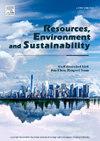在复合极端气候的压力下,澳大利亚的陆地储水
IF 12.4
Q1 ENVIRONMENTAL SCIENCES
引用次数: 0
摘要
很大一部分人口未来可能面临复合极端气候带来的风险,这将威胁到粮食和水安全。为了了解这些极端事件对当代人和子孙后代生计的深远影响,我们需要不那么模糊、更适合影响研究、更有能力推进我们对未来气候条件(如降雨和温度)理解的模型。为了提高澳大利亚复合极端天气影响评估的建模能力,我们开发了一个新的框架,将卫星重力数据与原位数据和水文模型的输出相结合,以调整最新的耦合模式比对项目阶段一般环流模型对水收支参数预测的偏差。然后评估了不同气候情景下的复合极端气候对由这些参数得到的淡水资源的影响。我们的研究结果表明,澳大利亚东海岸将经历复合极端炎热和极端潮湿的增加,在不同的气候情景下,这些复合极端天气的变化将导致澳大利亚的淡水短缺。还确定了将全球变暖限制在不同水平(历史、SSP 245、370和585)对淡水的影响。我们发现澳大利亚的淡水资源显著减少,在所有全球变暖情景中,西澳大利亚受复合极端气候(极端潮湿和极端炎热)的影响最大。淡水中超过-125%的相当大的百分比变化与这些复合极端有关。我们的研究结果还表明,蒸散发将成为淡水可用性的一个更重要的指标,并且大气动力学和水分输送预计会导致淡水可用性的相当大的变化。本文章由计算机程序翻译,如有差异,请以英文原文为准。

Terrestrial water storage in Australia under stress from compound climate extremes
A large proportion of human population could be exposed to future risks from compound climate extremes, which are threatening food and water security. To understand the far-reaching impacts of these extremes on the livelihoods of current and future generations, we need models that are less ambiguous, better suited for impact studies, and more capable of advancing our understanding of future climatic conditions (e.g., rainfall and temperature). To advance such modelling capabilities for impact assessment of compound extremes in Australia, we develop a new framework to combine satellite gravity data with in-situ data and outputs from hydrological models to adjust for biases in the latest Coupled Model Intercomparison Project Phase general circulation models’ projections of water budget parameters. The impacts of compound climate extremes under different climate scenarios on the freshwater derived from these parameters were then assessed. Our findings show that the Australian east coast will experience a rise in compound hot and wet extremes, and changes to these compound extremes under different climate scenarios will drive freshwater deficits in Australia. The consequences of limiting global warming to different levels (historical, SSP 245, 370, and 585) on freshwater were also identified. We found significant freshwater declines over Australia with Western Australia being the most affected by compound climate extremes (wet and hot extremes) across all global warming scenarios. Considerable percentage changes exceeding -125% in freshwater have been linked to these compound extremes. Our results also reveal that evapotranspiration will emerge as a more crucial indicator to freshwater availability, and that atmospheric dynamics and moisture transport are expected to contribute to considerable changes in freshwater availability.
求助全文
通过发布文献求助,成功后即可免费获取论文全文。
去求助
来源期刊

Resources Environment and Sustainability
Environmental Science-Environmental Science (miscellaneous)
CiteScore
15.10
自引率
0.00%
发文量
41
审稿时长
33 days
 求助内容:
求助内容: 应助结果提醒方式:
应助结果提醒方式:


